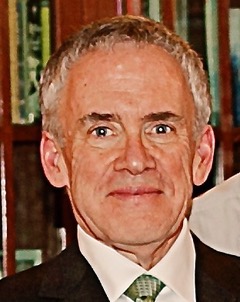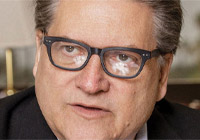DONALD SHOUP IS AN EVANGELIST. What he preaches is nothing short of a reformation. About parking.
Shoup, a distinguished professor of urban planning at UCLA, says the subject is not compelling for most university researchers. He calls himself an academic “bottom feeder.”
But many of his ideas have taken root and led some cities and fellow urban planners to reappraise parking, land use and traffic, along with meter revenue and the public good.
Avuncular, with bright eyes and an engaging laugh, Shoup is an economist by training. He has been called a “parking rock star” by the Wall Street Journal. As a result, he uses the handle Shoup Dogg. Devotees of his theories have formed a Facebook group called the Shoupistas, which has more than 4,500 members.
A book he has written, The High Cost of Free Parking, and one he has edited, Parking and the City, have become bibles for his crusade.
“Donald Shoup,” said former Massachusetts governor Michael Dukakis, the Democratic Party’s presidential nominee in 1988, “has done more to revolutionize the way we think about parking than anybody else on the planet.”
But systemic change is slow at the curb and between the parking lot lines. It requires much political capital, as well as a willingness to embrace a broader picture. Most people see parking as “a personal issue, not a policy question,” Shoup said, during an interview in his office at the Luskin School of Public Affairs. Parking “is the most emotional issue in transportation.”
That is why reason and logic often go out the window in discussions about parking. Market rate pricing is fair game in the cost of vehicles, tires, batteries and insurance. But parking? Many seem to see free parking as a right, almost a divine one.
“Analytic faculties seem to shift to a lower level,” Shoup writes in Parking and the City. “Some strongly support market prices, except for parking. Some strongly oppose subsidies, except for parking. Some abhor planning regulations — except for parking. Some insist on rigorous data collection and statistical tests — except for parking.”
For Shoup, this means connecting dots in unconventional ways.
“I always try to show how parking affects whatever people do care strongly about,” he said, “such as affordable housing, climate change, economic development, public transportation, traffic congestion and urban design.”
Too many cars, too little space
PARKING POLICY IN THIS COUNTRY has been around since the 1920s, when suddenly there were too many cars and too few parking spots on Main Street America. Off-street parking was developed as a solution to the crunch. It was not a bad idea in theory, Shoup says in The High Cost of Free Parking, except that regulations required enough parking for peak demand at any business.
Generally, peak demand comes at a fixed time, so parking lots sit half-empty or completely deserted for long periods.
Availability of parking at peak demand also encourages people to drive. They shop at one store, climb back into their cars and drive to the next store. Parking begets driving, driving begets cars, cars beget pollution and traffic congestion — all at the expense of walking, quality of life and human engagement.
In his preface to The High Cost of Free Parking, Shoup notes that 87% of all trips in the United States are made by personal vehicle, and only 1.5% by public transit.
But parking is land, Shoup said, and land always comes at a price.
Parking requirements for new condominiums, apartment complexes and commercial buildings perpetuate a theology of cars being the standard for transportation. If a tenant has two parking spots, the inclination is to have a vehicle in each.
Disney Hall: a case study
ONE OF SHOUP’S FAVORITE STORIES is about long delays and huge cost overruns during construction of the Walt Disney Concert Hall in downtown Los Angeles. Much of it was caused by parking requirements. The Disney Hall garage has six levels, holds 2,188 vehicles and took $110 million to build. The seasonal schedule for the hall, he said, was set with an eye on parking revenue to pay debt service on just the garage.
Then, Shoup added, came the issue of usage. Disney parking might be full for four hours several evenings a week. But at 10 a.m. on a Tuesday? Not so much.
The Disney Hall experience is in sharp contrast to what one finds at the Louise M. Davies Symphony Hall, the much older home of the San Francisco Symphony. It has no parking garage. People arrive by public transit, taxi, Uber … Before or after events, concertgoers engage in the neighborhood, at local bars and restaurants.
The community thrives.
Land use is obviously at play, Shoup said, and as construction costs soar and housing stock plummets, land use policy takes on a greater significance.
Too many Americans are sleeping on the streets, he said, while too many vehicles are living inside.
What the reformation looks like
A parking reformation, Shoup said, is imperative. His thinking has three tenets:
1) End off-street parking requirements: Setting the right number of parking places is, at best, an inexact science, Shoup said, and cities need to back off. He favors letting developers and businesses decide how many parking spaces to provide.
2) Price on-street parking right. Some call this finding the Goldilocks formula. On-street fees should balance supply of spaces with demand at any time of day. The right price is the lowest that will leave one or two spaces open on each block. The price must not be too high or too low but just right to facilitate supply.
3) Spend parking revenue to improve public services on metered streets. If people see positive results, then the meters become more acceptable. This has been the key to success of parking benefit districts like the one in historic Old Pasadena, which has been returning parking revenue to area infrastructure — smart-looking alleys, tidy sidewalks, well-paved roads — since the early 1990s.
Some of Shoup’s advice is being followed with good success in areas of Santa Rosa and Redwood City in California as well as Washington, D.C.
The most notable example of his influence is in San Francisco, where SFPark is meeting 60% to 80% of its occupancy goals by varying prices to keep some on-street parking spots open. Recently, Mayor London Breed has spoken of possible congestion pricing on crowded roads at peak times and of charging for parking in the evenings and on Sundays, which Shoup has long advocated.
Private affluence, public squalor
SHOUP, A NATIVE OF LONG BEACH, parked at Yale long enough to earn four degrees, one in electrical engineering and three in economics, including a PhD in 1968. He came to UCLA in 1974.
At the Westwood campus, he has been a leading force in making UCLA leadership understand the real costs of building additional parking structures, and his lobbying helped create a financial incentive program for students, staff and faculty to take public transit to work.
He and his colleagues also are studying the abuse of placards for disabled parking. Shoup says the cost of placard abuse in Westwood Village alone totals more than $1 million annually. It is a statewide problem.
“Equal access under the Americans With Disabilities Act should mean convenient, free parking for every person with a fundamental disability,” he has written, “not free parking for every car with a disability placard.”
Shoup suggests a two-tiered solution modeled after existing practices in Illinois and Michigan. That model takes into account different levels of disability, so that drivers with severely limited mobility can park free at meters.
He also has been thinking for several years about solutions for L.A.’s sidewalk infrastructure problem. “If L.A. started charging for curb parking at the fair market price,” he said, “we’d have enough money to fix all of our broken sidewalks.
“I walk through this neighborhood on my way to campus, and the houses sell for $3, 4, 5 million. It’s like a full-time job to live in them. And the sidewalks are in terrible shape. It’s a perfect example of what John Kenneth Galbraith called private affluence in public squalor. That’s what we have in L.A.”
As our interview ended, Shoup confided, “Most of my good ideas come to me when I’m swimming. And what I was thinking today is that — I’m teaching a course on parking — and I’m going to say that L.A. pays for its free curb parking with its broken sidewalks.”
























